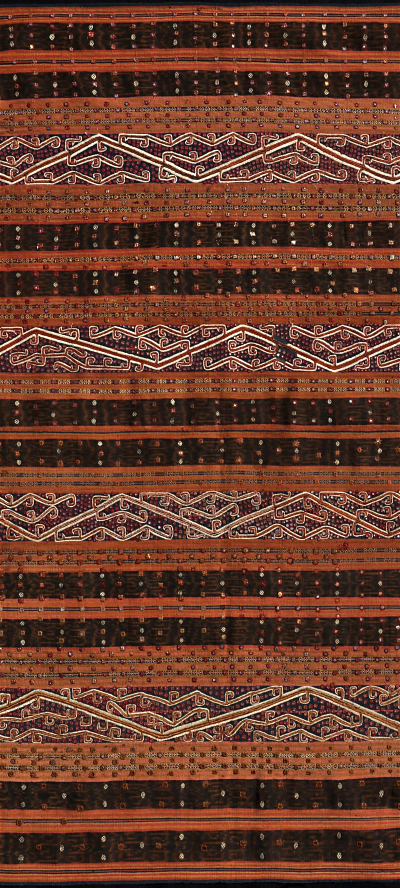| |
 
 | | | |
241 Sumatra, Kaur
Tapis (sarong)  
| | | Period: | Mid 19th to very early 20th c. | | Yarn: | Cotton, hand-spun, fine | | Technique: | Warp ikat | | Panels: | 1 | | Size: | 106 x 124.5 cm (3' 5" x 4' 1") LW: 1.17 | | Weight: | 900 g (31.7 oz), 682 g/m2 (2.23 oz/ft2) | | Design: | Kaur tapis kaca; kaca meaning 'glass'. Ten brown bands subtly decorated in warp ikat, with a pattern reminiscent of reticulated snake skin. Four wide bands overlaid with silk embroidery. Myriad tiny round mica sequins, cermuk, have been attached by couching, probably more than a thousand. | | Comment: | Antique tapis kaca with excellent ikat, beautiful embroidery and couching of mica sequins. Very good state of preservation. Even the embroidery, which tends to fray with age, is nearly perfect, with only one very small section rubbed off, colours are strong. A real pusaka which may have been used only once a year. Very hard to age, as this style has been in use for centuries with little change over time except drop in quality. The cloth looks and feels old, the cotton almost brittle. The workmanship is above average, which points to early manufacture. Another pointer towards substantial age is the 'wildness' of the yarn, with remarkable difference in thickness. Cloth was opened up for display; photo shows it as it was when sewn into sarong. [Note that at least half the weight represents the mica.] | | Background: | Chapters on Sumatra and Kaur. | | Exhibited: | Hong Kong University Museum and Art Gallery, 2017. | | Published: | Ikat Textiles of the Indonesian Archipelago, 2018.
| | Compare: | 227 168 226 | | Sources: | Near identical to 1880-1890 tapis in the Deutsches Textilmuseum in Krefeld depicted in Khan Majlis, Indonesische Textilien, Wege zu Goettern und Ahnen. Abb. 137. Very similar to one in Hunt Kahlenberg, Traditional Textiles of Sumatra from the Atlantic Richfield Company, Fig. 6. Similar to opened-up tapis in Hunt Kahlenberg, Textile Traditions of Indonesia, Fig. 4. but with ikated fond. Very similar to 19th c. example in RISD Museum, No. 2004.53.6.jpg | | |

©Peter ten Hoopen, 2025
All rights reserved.
|
|


